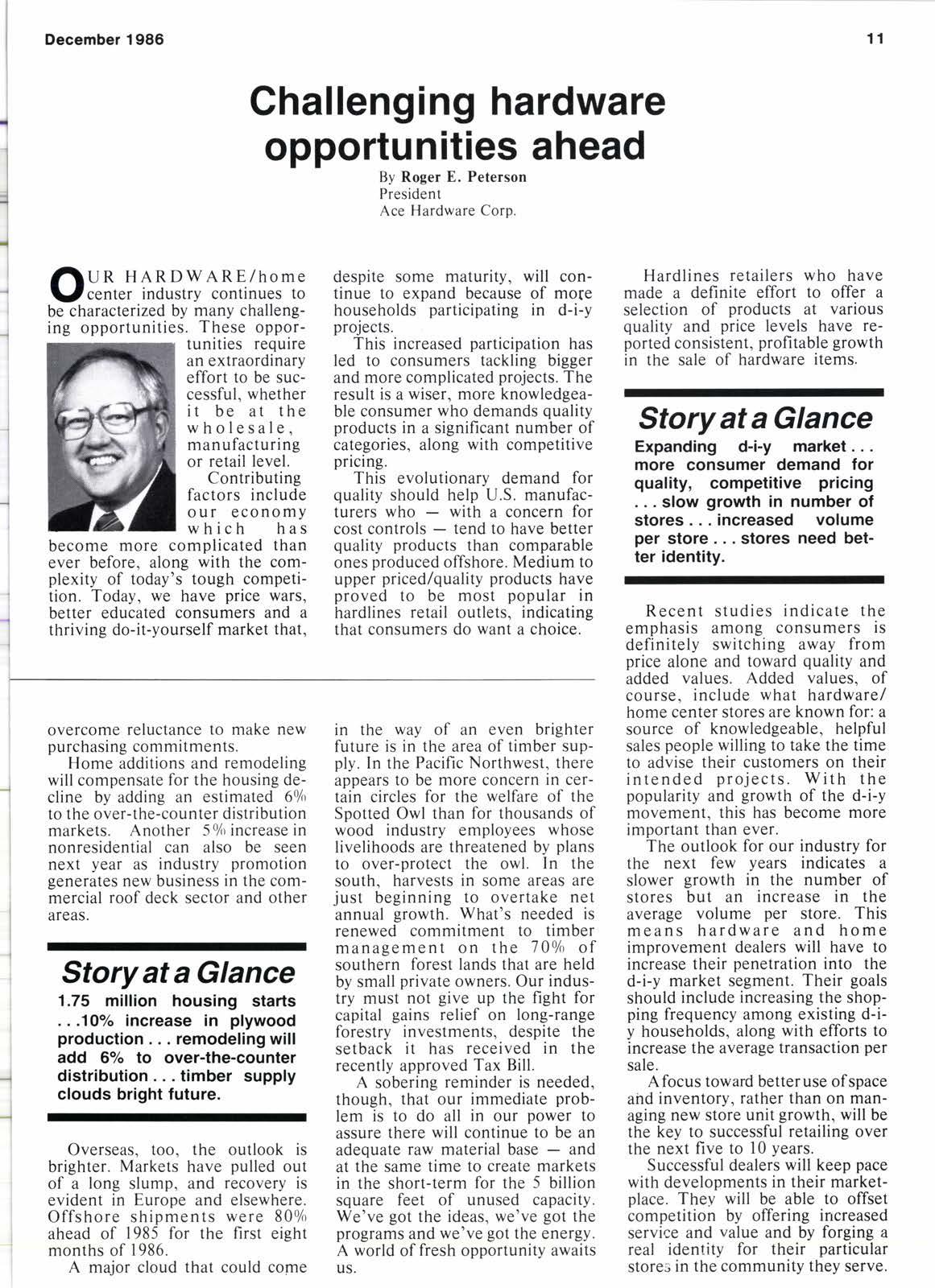
3 minute read
Challenging hardware opportunities ahead
By Roger E. Peterson President Ace Hardware Corp.
Ogn*fr5""#t*,i{H,-,:
be characterized by many challeng- ing opportunities. These opportunities require an extraordinary effort to be successful, whether it be at the wholesale, manufacturing or retail level.
Contributing factors include our economywhich has become more complicated than ever before, along with the complexity of today's tough competition. Today, we have price wars, better educated consumers and a thriving do-it-yourself market that, overcome reluctance to make new purchasing commitments.
Home additions and remodeling will compensate for the housing decline by adding an estimated 6% to the over-the-counter distribution markets. Another 5 o/o increase in nonresidential can also be seen next year as industry promotion generates new business in the commercial roof deck sector and other areas.
Story at a Glance
1.75 million housing starts
.1oo/o increase in plywood production . . remodelingwill add 60lo to over-the-counter distribution.. timber supply clouds bright future.
Overseas. too. the outlook is brighter. Markets have pulled out of a long slump, and recovery is evident in Europe and elsewhere. Offshore shipments were 800/o ahead of 1985 for the first eight months of 1986.
A major cloud that could come despite some maturity, will continue to expand because of mo(e households participating in d-i-y projects.
This increased participation has led to consumers tackling bigger and more complicated projects. The result is a wiser, more knowledgeable consumer who demands quality products in a significant number of categories, along with competitive pncrng.
This evolutionary demand for quality should help U.S. manufacturers whowith a concern for cost controlstend to have better quality products than comparable ones produced offshore. Medium to upper priced/quality products have proved to be most popular in hardlines retail outlets, indicating that consumers do want a choice.
Hardlines retailers who have made a definite effort to offer a selection of products at various quality and price levels have reported consistent, profi table growth in the sale of hardware items.
Story at a Glance
Expanding d-i-y market. . more consumer demand for quality, competitive pricing . slow growth in number of stores. increased volume per store stores need better identity.
in the way of an even brighter future is in the area of timber supply. In the Pacific Northwest, there appears to be more concern in certain circles for the welfare of the Spotted Owl than for thousands of wood industry employees whose livelihoods are threatened by plans to over-protect the owl. In the south, harvests in some areas are just beginning to overtake net annual growth. What's needed is renewed commitment to timber management on the 70% of southern forest lands that are held by small private owners. Our industry must not give up the fight for capital gains relief on long-range forestry investments, despite the setback it has received in the recently approved Tax Bill.
A sobering reminder is needed, though, that our immediate problem is to do all in our power to assure there will continue to be an adequate raw material baseand at the same time to create markets in the short-term for the 5 billion square feet of unused capacity. We've got the ideas, we've got the programs and we've got the energy. A world of fresh opportunity awaits us.
Recent studies indicate the emphasis among consumers is definitely switching away from price alone and toward quality and added values. Added values, of course, include what hardware/ home center stores are known for: a source of knowledgeable, helpful sales people willing to take the time to advise their customers on their intended projects. With the popularity and growth of ttre d-i-y movement, this has become more important than ever.
The outlook for our industry for the next few years indicates a slower growth in the number of stores but an increase in the average volume per store. This means hardware and home improvement dealers will have to increase their penetration into the d-i-y market segment. Their goals should include increasing the shopping frequency among existing d-iy households, along with efforts to increase the average transaction per sale.
Afocus toward betteruse ofspace ahd inventory, rather than on managing new store unit growth, will be the key to successful retailing over the next five to 10 years.
Successful dealers will keep pace with developments in their marketplace. They will be able to offset competition by offering increased service and value and by forging a real identity for their particular stores in the community they serve.










